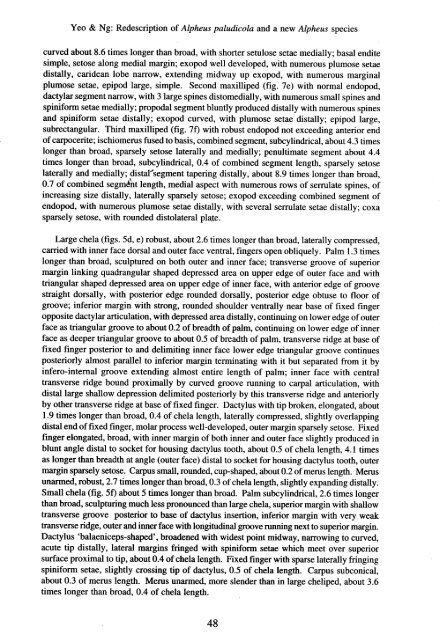a new species of freshwater snapping shrimp, alpheus cyanoteles
a new species of freshwater snapping shrimp, alpheus cyanoteles
a new species of freshwater snapping shrimp, alpheus cyanoteles
Create successful ePaper yourself
Turn your PDF publications into a flip-book with our unique Google optimized e-Paper software.
curved about 8.6 times longer than broad, with shorter setulose setae medially; basal endite<br />
simple, setose along medial margin; exopod well developed, with numerous plumose setae<br />
distally, caridean lobe narrow, extending midway up exopod, with numerous marginal<br />
plumose setae, epipod large, simple. Second maxilliped (fig. 7e) with normal endopod,<br />
dactylar segment narrow, with 3 large spines distomedially, with numerous small spines and<br />
spiniform setae medially; propodal segment bluntly produced distally with numerous spines<br />
and spiniform setae distally; exopod curved, with plumose setae distally; epipod large,<br />
subrectangular. Third maxilliped (fig. 7f) with robust endopod not exceeding anterior end<br />
<strong>of</strong> carpocerite; ischiomerus fused to basis, combined segment, subcylindrical, about 4.3 times<br />
longer than broad, sparsely setose laterally and medially; penultimate segment about 4.4<br />
times longer than broad, subcylindrical, 0.4 <strong>of</strong> combined segment length, sparsely setose<br />
laterally and medially; distal··segment tapering distally, about 8.9 times longer than broad,<br />
0.7 <strong>of</strong> combined segmt!ht length, medial aspect with numerous rows <strong>of</strong> serrulate spines, <strong>of</strong><br />
increasing size distally, laterally sparsely setose; exopod exceeding combined segment <strong>of</strong><br />
endopod, with numerous plumose setae distally, with several serrulate setae distally; coxa<br />
sparsely setose, with rounded distolateral plate.<br />
Large chela (figs. 5d, e) robust, about 2.6 times longer than broad, laterally compressed,<br />
carried with inner face dorsal and outer face ventral, fingers open obliquely. Palm 1.3 times<br />
longer than broad, sculptured on both outer and inner face; transverse groove <strong>of</strong> superior<br />
margin linking quadrangular shaped depressed area on upper edge <strong>of</strong> outer face and with<br />
triangular shaped depressed area on upper edge <strong>of</strong> inner face, with anterior edge <strong>of</strong> groove<br />
straight dorsally, with posterior edge rounded dorsally, posterior edge obtuse to floor <strong>of</strong><br />
groove; inferior margin with strong, rounded shoulder ventrally near base <strong>of</strong> fixed finger<br />
opposite dactylar articulation, with depressed area distally, continuing on lower edge <strong>of</strong> outer<br />
face as triangular groove to about 0.2 <strong>of</strong> breadth <strong>of</strong> palm, continuing on lower edge <strong>of</strong> inner<br />
face as deeper triangular groove to about 0.5 <strong>of</strong> breadth <strong>of</strong> palm, transverse ridge at base <strong>of</strong><br />
fixed finger posterior to and delimiting inner face lower edge triangular groove continues<br />
posteriorly almost parallel to inferior margin terminating with it but separated from it by<br />
infero-intemal groove extending almost entire length <strong>of</strong> palm; inner face with central<br />
transverse ridge bound proximally by curved groove running to carpal articulation, with<br />
distal large shallow depression delimited posteriorly by this transverse ridge and anteriorly<br />
by other transverse ridge at base <strong>of</strong> fixed finger. Dactylus with tip broken, elongated, about<br />
1.9 times longer than broad, 0.4 <strong>of</strong> chela length, laterally compressed, slightly overlapping<br />
distal end <strong>of</strong> fixed finger, molar process well-developed, outer margin sparsely setose. Fixed<br />
finger elongated, broad, with inner margin <strong>of</strong> both inner and outer face slightly produced in<br />
blunt angle distal to socket for housing dactylus tooth, about 0.5 <strong>of</strong> chela length, 4.1 times<br />
as longer than breadth at angle (outer face) distal to socket for housing dactylus tooth, outer<br />
margin sparsely setose. Carpus small, rounded, cup-shaped, about 0.2 <strong>of</strong> merus length. Merus<br />
unarmed, robust, 2.7 times longer than broad, 0.3 <strong>of</strong> chela length, slightly expanding distally.<br />
Small chela (fig. 5f) about 5 times longer than broad. Palm subcylindrical, 2.6 times longer<br />
than broad, sculpturing much less pronounced than large chela, superior margin with shallow<br />
transverse groove posterior to base <strong>of</strong> dactylus insertion, inferior margin with very weak<br />
transverse ridge, outer and inner face with longitudinal groove running next to superior margin.<br />
Dactylus 'balaeniceps-shaped', broadened with widest point midway, narrowing to curved,<br />
acute tip distally, lateral margins fringed with spiniform setae which meet over superior<br />
surface proximal to tip, about 0.4 <strong>of</strong> chela length. Fixed finger with sparse laterally fringing<br />
spiniform setae, slightly crossing tip <strong>of</strong> dactylus, 0.5 <strong>of</strong> chela length. Carpus subconical,<br />
about 0.3 <strong>of</strong> merus length. Merus unarmed, more slender than in large cheliped, about 3.6<br />
times longer than broad, 0.4 <strong>of</strong> chela length.
















